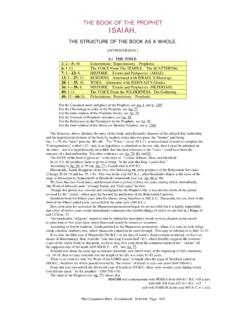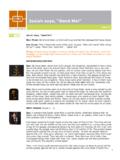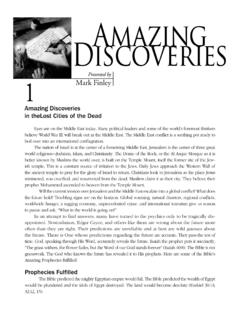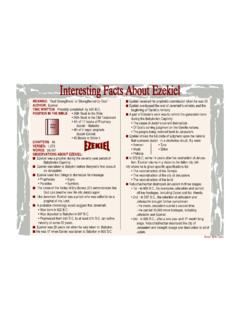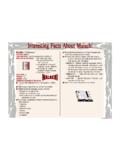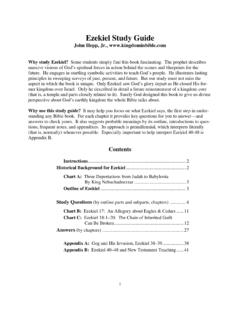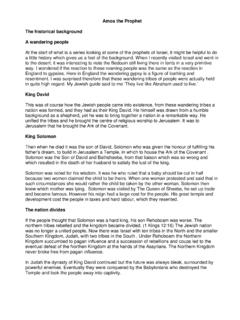Transcription of Mark 11:1-26 Study the Text - The Radical Experiment
1 Small Group Guide Week 35 Fruit and Faith The Church at Brook Hills November 1-7, 2010 mark 11 Fruit and Faith, November 1-7, 2010 | Page 1 This guide is to help you facilitate discussion with your Small Group. Use it as a resource to lead your group in discovering and owning the truths of God s Word. There may be questions you do not want to use and there may be instances where you just want to focus on a particular point or truth. Some questions may bring out emotions and cause people to dwell on their relationship with God. Your role is to facilitate this experience not to complete the discussion guide. Use this as a flexible teaching tool not a rigid teaching task list. Mark 11:1-26 mark 11 covers a lot of ground as Jesus enters Jerusalem riding on a colt, curses a fig tree, cleanses the temple and then teaches the disciples about faith and forgiveness.
2 The stories do not seem related, but Mark has woven them together to teach us about Christ s character and the necessity of faith. As you Study the chapter ask yourself, Why are these stories and events interwoven? Study the Text .. mark 11 :1-10: Jesus is the Messianic King! Read Zechariah 9:9. The passage opens emphasizing Jesus prophetic knowledge. He told his disciples exactly where to go to get the colt, and how people would respond to them. Mark then emphasized that the colt had never been ridden. In Old Testament and Jewish origins unbroken colts had a religious or royal use; furthermore, no one was ever allowed to ride the king s animal. Up until this point Jesus has been walking everywhere, but this time he wants to ride into Jerusalem. Then, the people call out to him. Read Psalm 118:25-26. The people praise Jesus and call out for him to save them. They are declaring him their king. Throughout the Gospel of Mark up until this point, Jesus has been careful to avoid the praises of the people, but now Jesus embraces their praise and does not deny that he is king.
3 Group Discussion .. The people praise Jesus as their king and savior, but later they will kill him. Is Jesus the kind of king they expected? Why or Why not? Do we sometimes have expectations of God that he does not fulfill? How do we respond when God does not do what we expect? How can we demonstrate trust in God even when he does not do what we expect him to do? Can we glorify God even when our personal expectations are not met? Study the mark 11 :11-25: God s people are called to bear fruit as they follow God with faith that can move mountains. With verse 11, Jesus enters Jerusalem and goes into the temple. As king, we can assume that he is going in to look around to see if his people have been faithful. He is not looking Small Group Guide Week 35 Fruit and Faith The Church at Brook Hills November 1-7, 2010 mark 11 Fruit and Faith, November 1-7, 2010 | Page 2 around like a tourist at the temple.
4 He is looking to see if his people are bearing fruit. The next morning as he is walking back to Jerusalem he curses a fig tree. This is rather odd behavior without the context that Mark provides. Jesus is not cursing the fig tree simply because he is hungry and there is no fruit. His action is symbolic. In the Bible, The fig tree often represents Israel (Jer. 8:13; Hos. 9:10, 16). So Jesus is saying that Israel has leaves and looks like she is bearing fruit, but in reality there is no fruit. What are the Jewish people doing that gives the impression that they are bearing fruit? Provide some examples found in the Gospel readings over the last two weeks. How should they have been bearing fruit? Jesus then enters Jerusalem and goes into the temple and drives out everyone who is selling and buying goods in the temple. This is an example of how the Jews looked like they were bearing fruit but were not. People came from all over the known world to worship in the temple.
5 It was not reasonable for them to bring an animal with them from home to worship; so many would buy the animal when they arrived in Jerusalem. The Jews are making it easy for people to worship by selling the animals in the temple complex itself! It seems like a good thing, but it is not. Why does Jesus have a problem with buying and selling being conducted in the temple? Are the people worshipping God with commerce taking place in the temple? Read Isaiah 56:1-8. How does God want to be worshipped? Does God desire the worship of other nations besides just Jews? How is the commerce keeping the Gentiles from seeking God? They made the temple a business, and they were robbing people because of the prices of the animals or the exchange rates they offered. They were exploiting people who were coming to worship God. The chief priests heard what Jesus did, and they wanted to kill him. However, they did not seek to arrest him in the temple because the people were astonished by Jesus and would have rioted.
6 The next morning when they entered Jerusalem the fig tree is withered to its roots. It portrays the coming judgment of Israel, but Jesus also uses it to teach the disciples about faith. If the disciples want to bear fruit, they must have faith that God will remove the mountains in their lives that seek to hinder them from following and bearing fruit for God. What kind of faith is Jesus seeking from the disciples? Strong? Weak? How does a person have faith that moves mountains? Can God forgive us if we have not forgiven another person? Why does Jesus tell them to forgive others when they are praying? Group Small Group Guide Week 35 Fruit and Faith The Church at Brook Hills November 1-7, 2010 mark 11 Fruit and Faith, November 1-7, 2010 | Page 3 What are some examples of how we sometimes bear lots of leaves but no fruit?
7 What is the difference between leaves and fruit? What is required for us to be able to bear fruit? Do our actions hinder others from worshipping God? Think about your small group, do your conversations or fellowship times together hinder guests or others in your group from worshipping God because of what you do or do not do? Think about our church, do we hinder one another from worshipping Christ with our actions or conversations whether it is during a worship gathering or during the week when we see one another? How does one develop or obtain a faith that can move mountains? How important is prayer to faith? What attitude should we have in prayer about the requests we make of God? Why is forgiveness so important? Chapter 11 began with Jesus entering Jerusalem as the promised Messianic king! Then instead of proceeding to build an army to free his people from their oppressors (Romans), he begins to judge his own people for their sins.
8 What is Jesus point by portraying himself as king and then focusing on the abuse of the temple? What kingdom is Jesus concerned about?




